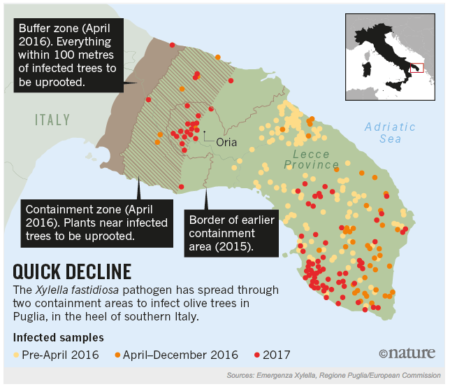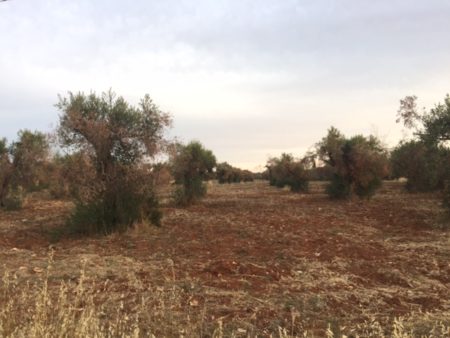- Ex-situ conservation of maize germplasm from different latitudes. You can do it, but not without some genetic changes.
- High density genotyping of the A.E. Watkins Collection of hexaploid landraces identifies a large molecular diversity compared to elite bread wheat. There’s plenty of interesting variation there, as you’d expect.
- Changes in barley (Hordeum vulgare L. subsp. vulgare) genetic diversity and structure in Jordan over a period of 31 years. No significant changes in the amount of genetic diversity in landraces collected in 1981 and in 2012, but later samples more homogenous and less locally distinct.
- Crop wild relatives range shifts and conservation in Europe under climate change. We’ll need genebanks.
- Isotope evidence for agricultural extensification reveals how the world’s first cities were fed. By opening up new land, basically, and never mind the fancy agronomic practices.
- Can the Introduction of Modern Crop Varieties in their Centre of Origin Affect Local Ecological Knowledge? A Case Study of Papaya in the Yucatan Peninsula. Yes, and not in a good way.
- Cryopreserved storage of clonal germplasm in the USDA National Plant Germplasm System. It really is a system.
- A meta-analysis of molecular marker genetic datasets for eastern Africa trees supports the utility of potential natural vegetation maps for planning climate-smart restoration initiatives. But you still have to do the trials.
- Global Diversity and Importance of Mycorrhizal and Nonmycorrhizal Plants. 72% of vascular plants have them.
- Factors associated with agrobiodiversity conservation: A case study on conservation of rice varieties in Barak valley, Assam, India. More connections means more varieties.
- Crop wild relative populations of Beta vulgaris allow direct mapping of agronomically important genes. Genotyping and phenotyping of 189 wild plants along a 10 km transect allows identification of disease resistance gene in the crops.
- Near Eastern Plant Domestication: A History of Thought. The punctuated-centric view is better, according to Occam.
- Fire and plant diversity at the global scale. They’re correlated, or at least associated.
Roundup on food composition, biodiversity and nutrition
FAO is leading global food composition activities since its beginning and has published several regional food composition tables. Since 1999, FAO is operating its food composition activities through INFOODS, the International Network of Food Data Systems, aiming to improve the quality, availability, reliability and use of food composition data. This fruitful collaboration has led to many instrumental standards, tools, databases and publications in the field of food composition, and more recently also on biodiversity. These public goods assist countries to generate, manage and use food composition data for different purposes. In collaboration with the Commission on Genetic Resources for Food and Agriculture (CGRFA) several documents on biodiversity and nutrition were elaborated, the most important being the Voluntary Guidelines for Mainstreaming Biodiversity into Policies, Programmes and National and Regional Plans of Action on Nutrition. This collaboration laid the foundation to more incorporation of nutrition into agriculture. The new tool ‘Nutrient Productivity Scale’, which combines yield, food composition and human nutrient requirements, may foster the inclusion of nutrition considerations into agriculture. The presentation will guide through all achievements over the last 15 and more years of food composition, biodiversity and part of nutrition-sensitive agriculture, its links within and outside FAO and will provide some food for thoughts for the future of food composition in FAO.
The presentation is online, and is well worth listening to in full.
The bit about the “Nutrient productivity scale” sounds a lot like something we talked about here some time back, and starts about 40 minutes in.
Squeezing olives
BTW, if you want to see what that “olive plague” we blogged about a few days ago looks like, here’s a despatch from the front lines by our intrepid photojournalist on the spot, Layla.
Incidentally, my attention has coincidentally recently been drawn to the Bioresources For Oliviculture (BeFOre) project (emphasis added):
The project aims at establishing a multi-lateral network of research and innovation staff active in OLIVE germplasm access, conservation, evaluation and exploitation, strengthening research capacities through the exchange of knowledge and expertise on a shared research programme focused on establishing integrated common protocols to phenotype and characterize plants at molecular, morphological and physiological level, and evaluating the olive oil quality related to varieties. Particular attention will be paid at establishing the international intellectual property rights for conserving and exchanging the olive genetic resources. The involvement of some Non Academic Organizations will allow the sharing of knowledge and ideas from research to all levels of the olive production chain, from plant propagation to fruit production and oil extraction (and vice-versa).
The bit about IPR is important because olives are not on Annex 1 of the International Treaty, at least for now, and one of the deliverables of the project is:
Core set of genotypes present in the main olive cultivar collections and grown under different agro-environmental conditions to evaluate their agronomical performance
Hopefully some of those genotypes are going to be of use against Xylella, either directly or through breeding.
Brainfood: Arracacha diversity, Mediterranean diet, Asian sheep & goats, Alpine flax, Breeding efficiency, Models, Domestication & seed size, Palm uses, CC & production, Insecticide & diversity
- Assessment of genetic relationships between cultivated arracacha (Arracacia xanthorrhiza Bancr.) and its wild close relatives in the area of domestication using microsatellite markers. Lots more variation in the wild, natch.
- Exploring Relationships between Biodiversity and Dietary Diversity in the Mediterranean Region: Preliminary Insights from a Literature Review. There has been an increase in dietary diversity, but of the wrong sort of diversity.
- Special issue Of Small Ruminant Research on “Genetic diversity of small ruminants in Asia”. From the Punjab Urial sheep to the goats of Myanmar.
- Genetic diversity of flax accessions originating in the Alpine region: a case study for an ex situ germplasm evaluation based on molecular marker. Past genebank conservation hasn’t been perfect.
- Enhancing genetic gain in the era of molecular breeding. It all starts with genetic variance. Hello, genebanks!
- Crops In Silico: Generating Virtual Crops Using an Integrative and Multi-scale Modeling Platform. Factor in gene editing and goodbye genebanks.
- Unconscious selection drove seed enlargement in vegetable crops. And not only vegetables, cereals too. But remember African rice?
- Palm economic and traditional uses, evolutionary history and the IUCN Red List. Globally, the more threatened palms are the less used.
- Impact of Climate Change, Weather Extremes, and Price Risk on Global Food Supply. The effect is not just on production, but also price.
- Identifying the landscape drivers of agricultural insecticide use leveraging evidence from 100,000 fields. In Kern County, California, crop diversity decreases insecticide us. But…
Italian olives still in trouble
In case you were wondering, the latest on the “olive plague” (Xylella fastidiosa) is that it’s spreading through the so-called containment areas. Oh joy.

It’s apparently all the fault of the “authorities,” according to a new audit of the control efforts, reported in Nature.
The commission’s audit, published on 31 May, includes a litany of failures by Italian authorities. It says that systematic monitoring of the infection began too late, and that there were ‘excessive delays’ in uprooting some infected trees. And the report charges that national and regional authorities have disbursed little more than half of the €10 million (US$11.2 million) budgeted for containment measures. Data obtained by Nature add further evidence of a slow response. In most of 2016, Italian laboratories processed almost no Xylella samples — indicating that monitoring had almost ceased (see ‘Lab drought’). Authorities did not respond to requests for comment.
But fear not…
There is some good news. Scientists in Puglia have identified two varieties of olive tree that are relatively resistant to the disease. Last month, the commission proposed that these could be planted in infected areas, to replace dead trees. But work to develop fully resistant trees could take a decade or more, says Martelli.
What a time to be alive.
